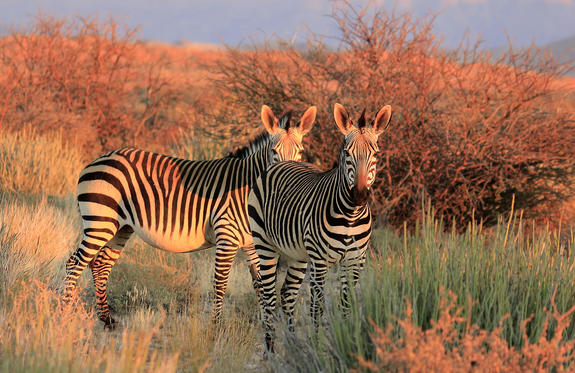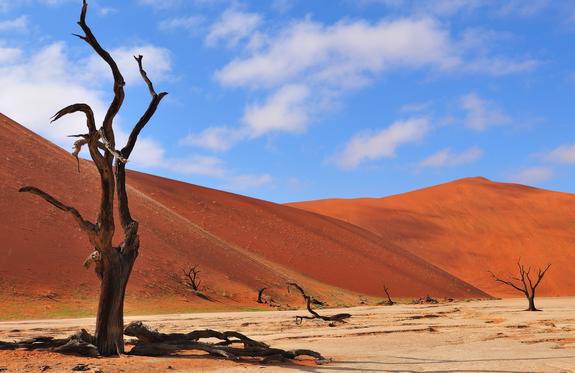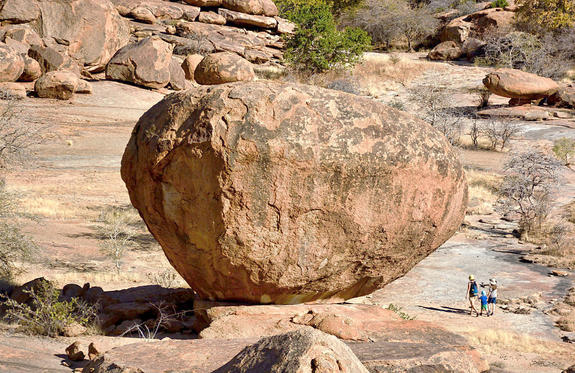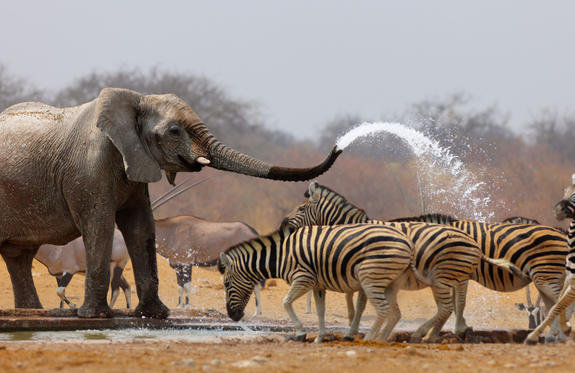Every country in the world displays some diversity, but South Africa, stretching from the lions in the Kruger National Park to the iconic Table Mountain in the Cape, takes some beating. Enjoy the Country’s sweeping valleys of the Winelands, Cape Town’s jumping nightlife, Namakwa’s springtime symphony of wildflowers or KwaZulu-Natal’s iSimangaliso Wetland Park which alone has five distinct ecosystems, attracting both zebras and dolphins - there is something here for any person with any interest of any age. Although the country has its fair share of problems, South Africans are some of the most upbeat, welcoming and humorous folk you’ll encounter anywhere, from farmers in the rural north who tell you to drive safely on those dirt roads, to Khayelitsha kids who wish you molo (‘good morning’ in Xhosa).

Synonymous with the birth of the international diamond trade, Kimberley is a picturesque little town with an extensive history. It was the first town to install electric street lights in the southern hemisphere, and today it is the largest city and capital of South Africa’s Northern Cape Province. Kimberly is renowned for the Big Hole, the largest man-made excavation in the world. Kimberley also featured prominently during the Anglo-Boer War when it was besieged by the Boers. History enthusiasts can visit the impressive historical attractions scattered throughout the town and explore some of the most famous battle sites of the Anglo-Boer war, which fringe the town.

Originally called Olijvenhoutsdrift, the historic town of Upington is set in the Northern Cape Province of South Africa. The Orange River Valley runs through the harsh and mysterious Kalahari landscape that surrounds Upington and it becomes obvious why this area is known as the Green Kalahari, with fertile valleys contrasted against semi-desert. Upington offers lush manicured gardens, stately trees lining wide boulevards and colourful flowers, creating a sense of peace and serenity. Meanwhile, the town’s bustling business centre provides visitors with more lively entertainment. Upington serves as the gateway to the impressive Augrabies Falls and to the expansive wilderness of the Kgalagadi Transfrontier Park. Visitors can learn about local history at the Kalahari Orange Museum, enjoy wine tasting at the local Orange River Wine Cellars, or take a sunset cruise down the Orange River on a floating bar.
Located in southwestern Africa, Namibia boasts a well-developed infrastructure, some of the best tourist facilities in Africa, and an impressive list of breathtaking natural wonders. Visitors can explore the capital of Windhoek and discover the lovely coastal town of Swakopmund boasting remnants of the country’s German influence, reflected in the architecture, culture, cuisine and the annual Oktoberfest celebrations. To properly appreciate this extraordinary country, you will have to venture out of the cities to explore the remarkable natural landscapes Namibia has to offer. These include: the impressive Fish River Canyon; the vast Etosha National Park teeming with abundant wildlife, such as lions, desert-adapted elephants and the Hartmann's Mountain Zebra; the hauntingly beautiful Kalahari Desert; and of course the Namib Desert stretching for over 2000 km along the magnificent Atlantic Coast. Namibia is an ideal destination for travellers seeking an unforgettable African experience in a uniquely beautiful untamed wilderness.

Carving out an epic rocky wonderland in the south of Namibia, the Fish River has created Africa’s largest and the world’s second-largest canyon. Hot, dry and stony, the Fish River Canyon measures a whopping 160 kilometres in length, at times 27 kilometres in width and 550 metres in depth. The awe-inspiring natural beauty of this ancient geological marvel draws visitors from around the globe. For those looking for adventure, the intense 85 kilometre Fish River Hiking Trail through1.5 billion years of geological history will definitely thrill avid adventure enthusiasts, and for visitors looking to relax, head over to the canyon's southern end to enjoy a soak in the mineral waters of the renowned hot springs of Ai-Ais, or take in the spectacularly scenic views from Hobas Restcamp as well as numerous other viewpoints along its rim. Other popular activities include: scenic chartered flights, horse riding, nature drives and seasonal kayaking.

Sandwiched between the rugged and stark Atlantic Coast and the arid desert of Namibia, the town of Luderitz is located in an incredible unique geographical setting. This seaside town is something of an anomaly frozen in time – a piece of 19th-century Bavaria bordering the pinkish sand dunes of the Namib Desert. Lutheran churches, German bakeries, and colonial buildings boasting German art nouveau architecture are dotted about the settlement, while its windswept beaches are home to flamingos, ostriches, seals, and penguins. The nearby ghost town of Kolmanskop, which has been taken over by the desert dunes, is another fascinating must-see attraction, located approximately 10 kilometres from Luderitz central, along with the herd of wild desert-adapted horses near the small town of Aus.

Set on the Trans-Namib Railway in the ǁKaras region of southern Namibia, the town of Keetmanshoop is known as the capital of southern Namibia. Founded in 1860, the quaint oasis is a living slice of history. German colonial architecture is dotted around the town and the local museum, housed in an old church, provides interesting insight into the town’s heritage. Just a short drive out of town, the Quiver Tree Forest is a sea of spikes and twisted trunks, while the neighbouring ‘Giant’s Playground’ is an evocative expanse of strange rock formations. Both offer superb opportunities for photography, particularly at sunset.

Situated in Central Namibia, the cosmopolitan city of Windhoek serves as the capital of the country. It is home to an international airport and a plethora of restaurants, shops, entertainment venues and accommodation options. The city is clean, safe and well-organised, with a colonial legacy that is reflected in its many German eateries and shops, and the widespread use of the German language. Windhoek has an interesting mix of historical architecture and modern buildings, many of which are worth a look, including the Alte Feste an old fort, the 1896 Christuskirche Christ Church, and the more contemporary Supreme Court.

Sossusvlei is where you will find the iconic red sand dunes of the Namib. The clear blue skies contrast with the giant red sand dunes to make this one of the natural wonders of Africa and a photographers heaven. Aside from the attractions at Sossusvlei - Dune 45, Hiddenvlei, Big Daddy and Deadvlei - other attractions in the area include the Sesriem Canyon and Namib-Naukluft National Park, where the mountains of the Namib meet its plains.

As previously described

Conveniently located only a few hour’s drive from Namibia’s capital city of Windhoek, the Erongo Mountain Range stretches across the plains between the towns of Omaruru and Karibib, and is home to a remarkably rich natural heritage. This expanse of rugged wilderness serves as one of Namibia’s most popular tourist drawcards, attracting visitors with its spectacularly scenic landscapes, magnificent caves and rock painting sites, and its impressive array of wildlife species. These include, among others: rhino, elephant, cheetah, leopard, giraffe, wildebeest, impala, blesbok, waterbuck, kudu, warthog, mountain zebra, oryx, eland, springbok and over 200 species of bird. Visitors can look forward to enjoying a variety of adventurous activities such as hiking, rock climbing, games drives, horse riding safaris and mountain biking.

A hidden gem found in Namibia's Otjozondjupa region, Otavi is a small farming town and peaceful gateway to the beautiful Otavi Mountainlands. As it offers a selection of cosy accommodation options, including bed and breakfasts, self-catering units, hotels, guest houses and camping facilities, the town serves as a convenient stopping point to nearby tourist attractions. Approximately 35 kilometres east of Otavi is the Ghaub Cave, a fascinating underground network of rock formations, calcified waterfalls, crystal clusters and 2.5 kilometres of channels, passageways, rocky halls and a glittering underground lake. Several kilometres past the cave is the famous Hoba Meteorite – the world's largest known meteorite found to date. For further exploration, Otavi's strategic position along the three-way intersection of the B1, B8 and the C39 ensures seamless access to the Etosha National Park, the Caprivi Strip, and the "Bushmenland".

Located in Northwestern Namibia, Etosha East is a protected sanctuary in the eastern part of the world-renowned Etosha National Park, known as one of the most accessible game reserves in Southern Africa. Etosha East boasts vast open plains scattered with semi-arid savannah grasslands dotted with watering holes and secluded bush camps. An impressive 5000-square-kilometre Etosha salt pan makes up a large area of the eastern side of the park and can even be seen from space. This remote area teems with abundant wildlife such as lions, elephants, black rhinos and giraffes, as well as a variety of birdlife featuring flamingos, ostriches, eagles, hornbills, and owls.

Tsumeb is the largest town in the Oshikoto region and the closest urban centre to the renowned Etosha National Park. It has been dubbed Namibia's 'Gateway to the North'. Tsumeb is also known for the famous Tsumeb Mine, and as having the greatest number of minerals in one place in the world. The region is rich in exquisite semi-precious gemstones which can be seen in their full glory at the Tsumeb Museum. Visitors can stop in at the Arts & Crafts Centre, the Tsumeb Cultural Village, and the Old Mine, which documents Namibia's rich history, before making their way to the famous Etosha natural area. Don't miss the opportunity to take in the town's raw and beautiful scenery in a different way: go skydiving with the Tsumeb Flying Club for a thrill of a lifetime.

Resting on Namibia's spectacular coastline just south of Swakopmund, Walvis Bay (Whale Bay) is a thriving town, Namibia’s principal harbour and one of the country’s most popular tourist centres. It is known for its natural lagoon, striking orange sand dunes and wealth of outdoor activities. Visitors can enjoy fishing, bird-watching, sailing, sandboarding, swimming, surfing and golf. Located just outside town is Dune 7, one of the largest sand dunes in the world, offering fantastic views from the crest for those with the energy to climb it. Other bucket list items include a trip to the expansive green and pink salt pans dotted with flocks of flamingos, and boat trips to see seals colonies, dolphins and friendly pelicans while enjoying champagne and oysters.





